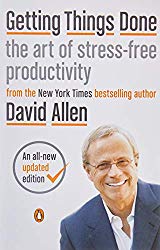“Getting Things Done” is a book by productivity-consultant David Allen that describes their famous time-management method of the same name (often referred to by its abbreviation “GTD”). It has become somewhat of a classic book on improving productivity for individuals and achieved this status almost as soon as it was published in 2001. It has its share of naysayers, but if you are someone who is overwhelmed by all the things that you have to do in your work or to achieve your personal goals, this might just be the book for you.
I should note that I have been skeptical of productivity-enhancement methods in general – if they are not snake oil outright, they either require adherence to a system that does not generalize well or require far too much discipline than is reasonable. I am sympathetic to the idea of enjoying the one life that you have when you can, instead of sacrificing it all at the altar of “productivity” and getting burned out. A simple “to-do list” of prioritized tasks (for each day as well as for the near future), subject to periodic reviews and accompanied by an optimized daily routine, has served me quite well over the years. So why then am I looking to improve my productivity? To answer that we need to take a slight personal detour.
As someone who is at their productive best in the mornings and on whose productivity fragmented meetings have a devastating effect, I have been fortunate enough to have had sympathetic managers and colleagues who let me set aside a blocked time-period in the mornings and who schedule most meetings where I am required only in the afternoons. I have also been lucky in working as an individual contributor with team-leadership and mentorship responsibilities throughout most of my career.
This permitted me to have the following rough routine every working day:
-
Process Emails – Create aggressive email-filters so that only
emails that require my attention are in my inbox. For example, I use filters
like:
list:foo@example.com -{to:me cc:me}in Gmail to set aside all emails from a given mailing-list except those that are meant for me. Read through each unread email in my inbox, replying quickly to it where I can, marking it unread where a quick reply will not suffice, and trashing or archiving it otherwise. - Unblock Others – Review code and documents from colleagues, providing feedback, the necessary approvals, etc.
- Create To-Do List – Identify what should be done that day based on my calendar, overflow from the previous day (if any), work scheduled for that day, etc.
- Work – Do the major task for the day, whether it is writing code or a document, while my energy-levels are high and while relatively fewer people are in the office to create distractions. Put on headphones playing some noise from myNoise to enhance focus.
- Everything Else – Attend meetings, catch up with mailing-lists and reading-materials, do lower-priority tasks, etc.
This worked very well for a while, but it has not worked that well in recent years. As I have taken on more responsibilities for a larger team that works with a greater number of other teams (both local and remote), I now have far too many things to handle effectively and I find that my productivity has taken a hit. This has not been helped by having to work in an open plan office and having an ever-increasing number of meetings at all hours of the day. I thus find myself looking for a better solution. I have heard good things about GTD over the years, but never had the need to look deeper into it. Until now.
The basic idea behind GTD is to reduce your stress by freeing up your mind and to improve your productivity by providing a process for gaining control over your work. You start by collecting all the “stuff” that is on your mind, both professional and personal, in a trusted system. These could be tasks to do, things to follow up on, errands to run, projects to undertake, etc. This can take quite a while, but it relaxes your mind by ensuring that everything that has been bothering you has been captured in this trusted system.
You then process this “in” list in order by identifying actionable items – items that require multiple actions go into a list of “projects” that merit planning in order to define the desired outcome and to enumerate further actions, while items that can be done in a single step are done immediately if they are small (need less than two minutes), delegated to someone else if they are better suited to do it than you, or deferred to be done at a later time. Non-actionable items that are still useful are either set aside to be considered at a later time or filed to be used as a reference; other items are discarded as trash. This workflow is shown by the following flow-chart (see the book for more details):

For an alternative and more detailed overview see this map at the GTD web-site. Alternatively, see this quick overview by Erlend Hamberg.
This collection and processing is not enough by itself, of course, so GTD has recommendations for organizing all the items that survive this process, regularly reviewing such items, and for actually doing things in a systematic fashion. Somewhat heretically, but providing good reasons for doing so, the author neither recommends maintaining to-do lists nor picking up tasks based simply on their priorities. Watch this video (after reading the book), where the author expands upon their approach a bit.
The interesting thing about GTD is that it does not mandate a particular system for following it, providing only the overall method and some guidelines. Another interesting thing is that it covers both your personal and your professional lives. I suspect that these aspects, as well as the continuing discipline needed to benefit from it, would make it difficult for most people to actually follow it fully. You can see that, for example, in comment-threads like this and this on Hacker News. To be fair though, it seems that most of these people have not actually read the book fully as the author explicitly addresses many of these things. There are also criticisms and alternatives provided by more famous people like, for example, Cal Newport and Leo Babuata.
Note that GTD does not provide guidelines on some aspects of productivity and well-being that are still very important for effectively doing your work, especially if it requires creativity and/or focus. For example, eating healthy food, getting good sleep, doing exercises regularly, having a stress-free commute, setting up an environment that allows you to do deep work with sustained focus, managing your time effectively, etc. are all critical for such work. You have to look elsewhere for guidance on these. Once you have these in place, GTD promises to let you work more efficiently and reduce your stress.
There are some anachronisms in the first edition of this book from 2001 that have seemingly been fixed in a subsequent revision in 2015. For example, the author repeatedly refers to Palm PDAs, Lotus Notes, Rolodex, etc. They also ask you to maintain 43 phyiscal files containing potential items for each of the 31 days in a month and for the 12 months of a year, which I highly doubt anyone would follow these days (and whether anyone actually did in those days as well).
I am not sure whether I can adopt this method lock, stock, and barrel. I rather like the “do, delegate, defer” part of the workflow, so I can perhaps start by applying that to at least the emails in my inbox. I also like the part about putting down all the “stuff” on your mind in a list and going through that systematically, so perhaps that could be the next step in adopting this method. Only time will tell whether I can be successful with this piecemeal approach.
